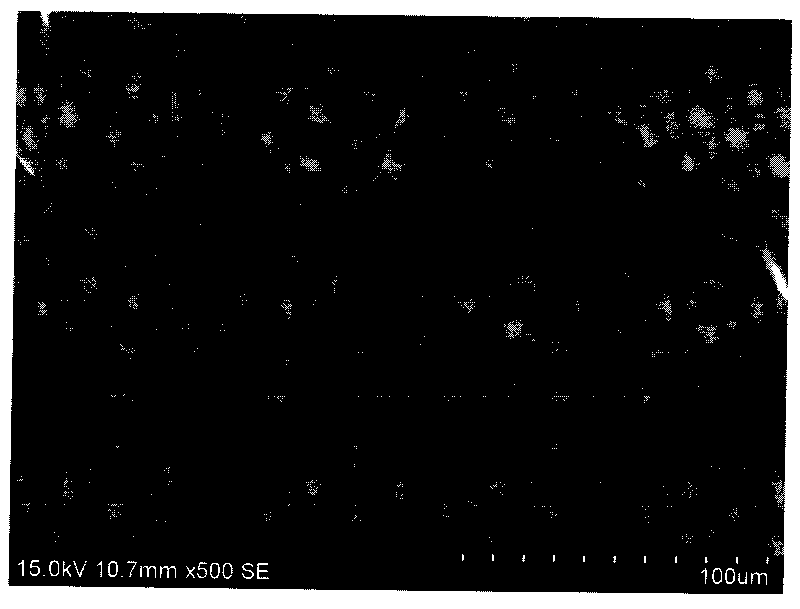Method for preparing foam glass by using waste silicon carbon material
A technology of foam glass and silicon carbon materials, which is applied in glass forming, glass manufacturing equipment, solid waste removal, etc., and can solve problems such as damage to silicon carbide rods, increase in contact resistance, corrosion or oxidation, etc.
- Summary
- Abstract
- Description
- Claims
- Application Information
AI Technical Summary
Problems solved by technology
Method used
Image
Examples
Embodiment 1
[0020] 1) Clean the waste flat glass, dry it, and ball mill it to more than 200 mesh, then clean the waste silicon carbon rod, dry it, and grind it to more than 200 mesh;
[0021] 2) Take 92% of the waste flat glass after ball milling, 3% of the waste silicon carbon rod after ball milling, 3% of borax and 2% of sodium fluorosilicate in the ball mill jar and ball mill to 200 mesh to prepare the mixed material;
[0022] 3) In the preheating stage, put the ball-milled mixture into the mold and raise the temperature to 400°C for 20 minutes at a heating rate of 10°C / min;
[0023] 4) In the foaming stage, the temperature is raised from 400°C to 800°C at a heating rate of 20°C / min;
[0024] 5) In the bubble stabilization stage, keep warm at 800°C for 20 minutes;
[0025] 6) In the rapid cooling stage, cool to 600°C at a cooling rate of 25°C / min and keep warm for 20 minutes;
[0026] 7) In the annealing stage, the cooling rate is 1°C / min, and the annealing is below 100°C to obtain ...
Embodiment 2
[0029] 1) Clean the waste flat glass, dry it, and ball mill it to more than 200 mesh, then clean the waste silicon carbon rod, dry it, and ball mill it to more than 200 mesh;
[0030] 2) Take 90% of ball-milled waste flat glass, 5% of ball-milled waste silicon carbon rods, 3% of borax and 2% of sodium fluorosilicate in a ball-milling jar and ball-mill to more than 200 mesh according to mass percentage. Mixture;
[0031] 3) In the preheating stage, put the ball-milled mixture into the mold and raise the temperature to 400°C at a heating rate of 11°C / min for 25 minutes;
[0032] 4) In the foaming stage, the temperature is raised from 400°C to 820°C at a heating rate of 18°C / min;
[0033] 5) In the bubble stabilization stage, keep warm at 820°C for 25 minutes;
[0034] 6) In the rapid cooling stage, cool to 590°C at a cooling rate of 20°C / min and keep warm for 25 minutes;
[0035] 7) In the annealing stage, the cooling rate is 2°C / min, and the annealing is below 100°C to obtai...
Embodiment 3
[0038] 1) Clean the waste flat glass, dry it, and ball mill it to more than 200 mesh, then clean the waste silicon carbon rod, dry it, and ball mill it to more than 200 mesh;
[0039] 2) Take 90% of ball-milled waste flat glass, 4% of ball-milled waste silicon carbon rods, 2% of borax and 4% of sodium fluorosilicate in a ball mill jar and ball mill to more than 200 mesh according to the mass percentage. Mixture;
[0040] 3) In the preheating stage, put the ball-milled mixture into the mold and raise the temperature to 400°C at a heating rate of 12°C / min for 30 minutes;
[0041] 4) In the foaming stage, the temperature is raised from 400°C to 790°C at a heating rate of 15°C / min;
[0042] 5) In the bubble stabilization stage, keep warm at 790°C for 30 minutes;
[0043] 6) In the rapid cooling stage, cool to 580°C at a cooling rate of 15°C / min and keep warm for 30 minutes;
[0044] 7) In the annealing stage, the cooling rate is 2°C / min, and the foam glass is obtained by anneal...
PUM
| Property | Measurement | Unit |
|---|---|---|
| density | aaaaa | aaaaa |
| flexural strength | aaaaa | aaaaa |
| density | aaaaa | aaaaa |
Abstract
Description
Claims
Application Information
 Login to View More
Login to View More - R&D
- Intellectual Property
- Life Sciences
- Materials
- Tech Scout
- Unparalleled Data Quality
- Higher Quality Content
- 60% Fewer Hallucinations
Browse by: Latest US Patents, China's latest patents, Technical Efficacy Thesaurus, Application Domain, Technology Topic, Popular Technical Reports.
© 2025 PatSnap. All rights reserved.Legal|Privacy policy|Modern Slavery Act Transparency Statement|Sitemap|About US| Contact US: help@patsnap.com

